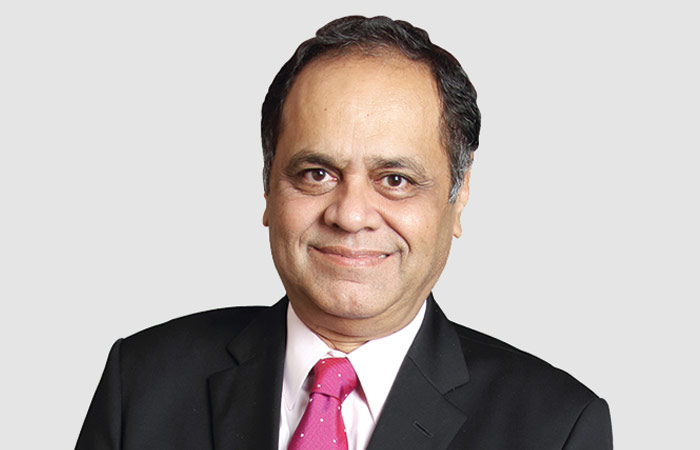By Krishna Kumar Mishra
Anyone who is a regular at Mumbai Samachar Marg before it abruptly ends at Bombay Stock Exchange, chances are high that he or she has seen a very tall, smartly dressed young man of 59, with a no-nonsense attitude, looking straight with an unassuming face walking across and entering in the imposing Jeejeebhoy Towers. Counted amongst the country’s most influential veteran investors, he is Ramesh Damani.
The well-read, and highly educated, Ramesh Damani became a member of the Bombay Stock Exchange in 1989. In last 28 years he has seen the markets through roller coaster rides and survived to tell the tale. He is admired for identifying potentially successful businesses and investing in them for the long term in classic Warren Buffett style.
Now when the world is moving through very turbulent time, and unexpected-never-imagined incidents happening, it is the right time to find out what the ace investor has to say. Here, in a freewheeling conversation, he shares with Krishna Kumar Mishra his take on the budget, investing themes and the throbbing bull market.
What is the core message, besides financial mumbo-jumbo, of this budget?
The first thing that we could observe was the lack of volatility for the two hours while the Finance Minister spoke. We found the Index was in a very narrow band. Typically the Index used to move at least 8-10%, even when the FM is speaking. It was extraordinary, absolutely the first time. The markets reacted positively with enthusiasm once the speech ended because most fears were dispelled. So in my opinion, it reflects the political maturity of the document that he presented to parliament. The second thing, of course, is that the two big bang reforms have already been done outside the budget – the demonetization and the GST. So this budget seeks to parlay the path ahead for these processes. I think demonetization is one of the arms we’ll see a lot of changes around – in terms of people paying not by cash and the outcome of the kind of information passed on to the Income Tax department. Those are what the Finance Minister called the transforming, energizing and cleansing part.
We’re now beginning to see the signs of corruption reducing in India and that will energize the country. Corruption was sucking the oxygen from the room, making us all believe in crony capitalism. I think for the first time we believe there is a level playing field. There is an intensity to doing business because decisions are based on merit and deliveries not necessarily on who your cronies are. So I think the budget was a very viable political document. There were no poorly calibrated measures. It continued the reform path which the government has started. I would rate the budget as a very sober and realistic political document and not at all financial mumbo jumbo.
Balancing is backed by large Income Tax collections, predominantly because of IDS, demonetization-led widening of taxpayers. So far so good. Is this not one-off trick. What next year?
There are two parts to the budgetary estimates for a strong growth – personal income tax collections and more moderate growth in corporate tax and excise tax. The government believes that by making tax more compliance, more investor friendly, more and more people will start coming into the tax net. So in that sense the government has delivered on its promise over fairer and cleaner administration in the tax system. Second, the demonetization benefit is going to be felt not only today, but in the future also. A large part of the unorganized economy will become organized and large part of the informal economy will become formal. So as people’s behavior change they will be scared to keep cash and if they start paying in cheque/credit card/e-wallet, the size of the formal economy will grow. Once the economy grows up the tax payment will also come better. Once that happens, interest rates will come down as the government would not have to borrow so much money. So we are entering into a virtuous cycle for the Indian economy. I think demonetization did involve some pain and it did lead to a shock to the system. But there was no other way to do it. If you had to clean up the system you have to have a plan. For almost 40 years we had been bemoaning about the amount of corruption in India. Here someone at least had a plan to try to put corruption behind us so the public has supported him. If India’s GDP resumes its growth rate of 8-8.5%, which is very much possible after one year, tax collection will remain very buoyant.
Stocks go up and down, that’s the nature of the beast. Risk is when you think you can permanently lose your capital. How you can permanently lose your capital is by buying a bad business. Volatility is something you have to stomach. If you want to make money in the stock market, you better get used to it.
Do you think the reduction in tax rates was not to the expected level?
Any time you reduce the burden it is a very good sign. Either saving percentage will increase or consumption will increase. But ultimately the money will come to the markets – through banking channels or through the listed companies in the market place. What is important is that while widening the tax net, make sure there is a fair administration of taxes. The Finance Minister pointed out a silly number of people making more than 50 lakh which is just not possible in a country as rich and diverse as India so there are so few people are in the tax net. Measures like electronically tracking payments, and by disallowing payments more than 3 lakh in cash will force people now to be a part of the formal system.
Was a clear statement on demonetization costs/benefits missing in the budget?
I don’t think so. The government estimated that maybe 2 lakh crore will come as a benefit because all the money wouldn’t be tendered. But they miscalculated. Obviously more money came in and merely 50,000 crore or so left, much smaller than the expectation. But we have not heard the last story about this because income tax authorities are going to watch who deposited how much cash at what time. Either these people have to declare this as income or they will face prosecution, if it is proved that this is unaccounted for income. But either way the country is now behind the demonetization theme in the sense that as you travel nobody is talking about a shortage of currency notes anymore.
The benefits are going to be a bit far and not in the near term. People, who postponed consumption, did not buy a fridge or washing machine, will ultimately come to buy it. In terms of services, there will be a one time loss. If you haven’t eaten in a restaurant you’ll probably go back and eat there. But there is always a price to pay for any major economic reform. The long term benefits are very great. The tax system in the country was inequitable. People paying taxes were harassed by the authorities. People not paying taxes were actually made out to be good citizens. So for the first time the taxpayers are getting some rights. The people who are not paying taxes are being pushed into a corner and that is good news for everybody.
You don’t agree with the demand that the government should have come out how much they collected and declare all those details?
The problem was that the number was smaller than they thought, so they did not necessarily want to publicize that number. There were some mistakes made in the planning, but you also have to look into the intangible benefits it will bring into the economy over the next two or three years. India is a lab that will be studied by every other country and a lot will change based on India’s experimental data. So the message is clear that the government is very serious and going to move to a cashless age, to the digital economy and if you are not changing your business to accept e-cash, to accept credit card payments you’ve a strong risk of being left behind. So it’s important for every citizen, every taxpayer to wake up and as they say in America –smell the coffee.
Electoral bonds – Does it address the issue or merely re-routing funds?
It’s not right to assume that people will not contribute to political parties because everyone has an agenda. Politicians found a great way to allow political funding by ordinary people, but still be anonymous. Anyone could give 25 lakhs in cash to a political party and his name was not known. Now by virtue of buying electoral bonds the only point you know is that you have raised money for a political party, to which party it has gone to there is no trace because it’s a negotiable transferable bond. It’s a very good solution. It will over time take out the stain of black money from our political system. Companies, that honestly deliver on economic reform, honestly deliver on the agenda that the public wants, will find a good option. This was a very thought out process. We need to compliment the FM for doing it because we could never go to a completely cashless economy as long as cash funding was available to the politicians. The corruption involved will severely come down as people are being watched, there is a limit how much cash is to be withdrawn, one can always be asked for what he withdrew it and what is his balances. So the big ticket corruption cannot happen anymore because people won’t have access to cash and everything else will be left with the digital trade. You are attacking 50-60 year old problem in India, which has never been addressed. It’s a step in the right direction.
Do you think nominal GDP growth 11.8% and real GDP growth of 6.75-7.5% can be achieved without greater fiscal support, especially when world trade is moving toward de-globalization resulting in moribund private investments?
The post World War II world was built by the big five, led by the US, the Great Britain, France, Japan and, to some extent Russia which was not part of the economic system. And it was built on certain principles that we’ll encourage globalization and encourage integration into the global economy. The US, because of its eminence, its strong economy and the size, would use the dollar extensively, would open up its market and it became the global currency.
Later the rise in the 1960s of the four tigers, Singapore, Taiwan, Korea and Hong Kong, happened. The US took goods from these countries and it would pay them in the dollar, which they reinvested back in the treasuries. As the experiment succeeded more and more emerging markets started doing the same thing – going towards an export oriented economy. Increasingly, the supply chains of any commodity whether it is the iPhone or textile, it’s global. You might source cotton from Bangladesh, stitch it in Vietnam, dye it somewhere else and market it in America. But it kept everyone busy and employed. So the free market has worked well and the level of poverty is diminishing in the world.
But there are pains associated with that. Suppose you make your car in Mexico and you’re somewhere in America the people employed in the auto industry there will feel bad. There will be new jobs created obviously as the economy will be fairly resilient but sometimes people live in ostrich holes and they do not understand that globalization means as someone said that you have to train, retrain and then retrain yourself, maybe three times in your career.
Then comes along a populist man who tells them that I’ll get your jobs back and people, because they are angry and hurt, will vote for him. And that’s what has happened in the US. What President Trump wants is what is called a Mercantilist policy which was very popular in 15th, 16th and 17th century. Mercantilism is economic nationalism, a system of political economy that sought to enrich the country by restraining imports and encouraging exports. It believes (the bad short hand translation is bigger than neighbor) that keep exporting, don’t import goods, keep up the balance of payments in your favor and everyone will be prosperous. Many centuries ago David Ricardo and Adam Smith have discarded this policy.
In modern India there is no other way that anyone can be rich with small amounts of money unless he starts investing in stock markets.
We strongly believe that every country has a competitive advantage and every country must seek to trade. It’s well established that it makes both countries more prosperous if they trade. What is going to happen now is say for example if Mr Trump says that any car coming from Mexico will attract a border tax of 10-20% making the car costlier. The countries, Mexico or Saudi Arabia or Philippines will say, ok, anytime you send the iPhone we’ll charge a 20% more on your phone. That would not be tolerable because then Samsung will get all the market. So you lead to a trade war. It’s going to badly affect the entire global economy and in fact, that is the biggest risk right now in the global equity markets.
The big present danger is that if you get into a trade war not only the US market goes into a spin, but all emerging markets will fall. The good news, of course, is that whatever Trump says he has to get it passed in two houses of the Congress. And generally they are more believers in free trade, in an open economy, and globalization. So they are not necessarily going to pass these bills. The first attempt to restrict H-1B Visa has been criticized by all the top corporates in America because they need that programming talent from emerging markets. So the number one worry right now is Donald Trump should not be allowed to turn the clock back on globalization. It’s obviously a huge source of worry for us. But what is happening in India is very good. I mean corruption coming down significantly, interest rates coming down, oil prices remaining down so we’re entering in a sweet spot. The hard work has been done and in the next two years the economy can really take off and give us superior than 8% growth which is what we need.
In fact the bull markets always climb a wall of worry. And this is a wall of worry that we see in 2017. Having said this, I think Indian markets will deliver positive returns in the last two years of this government.
Any other Donald Trump effect that you can specify?
The Donald Trump effect on India is very sharp because he is saying that he will ban H-1B Visas. In fact make them more non-competitive. It’s not well thought out in my opinion because while unemployment in America is about 4.5%, unemployment in the technology sector is under 3%, which in effect means fully employed. If you want to create world class companies – the Facebook, the Google, the Snapchat – the companies that have taken the world by storm and today are worth a few hundred billion dollars each, you need programming talent. Programming talent or brain power is the raw material for these companies. It’s not like iron, steel or cotton. All the way from Pune in India to Poland that’s where the programming talent comes from and for them not to be able to go to the US, the American companies will become non-competitive soon. So I think after some thought and after some interaction with captains of industries Donald Trump is likely to reverse his stand. So in the long term the technology companies will continue to do well.
In that scenario, do you see 10-year G-Sec yields rising?
I don’t see them rising in India, but we’ll see a little bit of a fall in interest rates. We’ve seen T Bill rise in America, for example. But India is going in opposite course, because it’s going to high base from a low base, from higher inflation to lower inflation, from high deficits to lower deficits. So India is probably in a better place and here we’ll see a rise in bond value but yield will start falling actually.
In view of missing earning growth, manufacturing slowdown, global headwinds for IT and pharma, what PE ratio is justified for the index.
There is an old saying that beauty is in the eyes of the beholder. So what PE ratio the market ascribes to which company and to which market is known by markets only. I don’t think any individual forecaster has enough ability to forecast the PE of the market. A frontier market might have a PE of 100 as people expect enormous growth to come in the next three years to justify this PE. Mature markets like Japan and America might be trading at 12 or 13. Typically emerging markets because they are going to grow better and they have a sense of currency being stable, the markets will reward that growth with higher PE. So as the Indian economy reforms and it accelerates its growth, we would expect higher PE. Typically we trade at 15-16 times earnings and we can go into 19-20 times band, particularly if growth picks between 9-10%. Then what will happen, there will be two sets of buyers in India. Domestic investors now entering the markets and foreigners who are also bullish on India. Typically, one sells and the other buys. This time both are turned buyers, which means that there could be a melt up in equity prices and equity valuations expanding the PE.
Investors have been so damaged by the fall in real estate and gold, that one of the big changes happening in Indian stock markets is, for the first time people are looking at the equities and the cultural psychology is finally shifting. This domestic money that’s coming to Indian stock markets, will be far greater than the foreign money over the next 10 years. Each month we’re getting another 1000 crore to the equity markets either through the SIP plans, portfolio, or through direct investment. One thing is clear that now people will take an opposite view – when foreigners are bearish about the emerging markets they will sell and domestics will come and buy which in the long term will probably be one of the very great change.
Which are promising sectors and investment ideas for the next year?
First, we should look at the companies that have ended making a 52 week high. That provides the indications where the markets interests are. In this list we find a lot of public sector names. There are a number of reasons – either they have given bonuses, or high dividends payouts which are very much investor friendly measures. A lot of large public sector stocks are in Oil & Gas which is having a very good run because now they are deregulated so they are doing very well. Plus the government has said that we’ll do two things – list more PSUs so there will be a lot of value unlocking and they’ll do some strategic disinvestment of selective PSUs like BEML, NMDC, SAIL and others. I think that is the sector that has visibility. There are companies like NBCC which have a five year visibility on their order book and the growth. I think these are the reasons the public sector stocks will do well.
Another sector that I’m bullish about is the new technology. Increasingly, we’re finding that people in Korea, Iran or even remote corners of the world are using the internet to send cyber threats across the world and there are different kinds of threats. In Ukraine a few days back the entire electricity grid was frozen by some Russian hackers. They have been also accused of their role in the US elections. So Cyber security will be a very common place.
Look at India. The moment you start paying through mobile phones the real money you’re really scared that someone will hack your phone, your computer or the office you’re transferring money over there. So we need a layer of protection. I think those companies who offer that layer of protection or coordinating with Aadhaar database will try to do well. And these are generally domestic focused companies not the big names who export to America where they are under trouble because of President Trump.
Can you name some of these companies?
Basically, there are some domestic focused companies in this segment addressing database, biometrics and virus. I would look at that set of companies and those will be my second pick. To name a few, HCL and Infosys maintain Aadhaar database, Quick Heal Technologies is into Antivirus software, Nucleus Software does the digital currency called PaySe, TVS Electronics sell terminals, Tata Communications is involved in network software. These are listed companies and there could be more in this segment. I’m not recommending any of these stocks because I’m not allowed as per SEBI regulations. I’m just suggesting that investors should look at companies that are focusing on the database, Aadhaar based payments and antivirus.
Any other sector that you’re focusing?
It is said that a rising tide lifts all ships. So if we see 8-10% GDP growth, then profit growth will be much higher, 15-16% in nominal terms. Many companies will do well, but particularly again, I would like those who help economy go from cash to cashless. I think cyber security and cash to cashless will be twin brothers. Investors will have to find companies in that area because there is a huge opportunity for someone who understands how this business works. We also continue to like the traditional sectors like FMCG. However, we express now in different ways. You not necessarily want to buy the old FMCGs companies like Hindustan Unilever or ITC. But there is another segment in that like fashion, retailing or those who are into fast-food. Those kinds of companies look like a good place to be in. I feel there is an outstanding opportunity in pharma because we’re low cost manufacturer. Pharma had been in a bit of trouble, but over the next two or three years they’ll continue to gain market share.
However, more than sectors, the trick is to remain invested in good businesses. People ask me – Oh! The market has gone up. Is there still time to invest? Oh! It has gone down. I want to say one thing. I joined the market in 1989 when Index was 600. It has gone to 30,000 now. So the Index itself is up 50 times and in that period you had so many economic catastrophes taking place in the country. India sold gold due to balance of payment crisis, the Communists came to power, governments were dissolved, the Kargil war, Plague in Surat, then the 2008 global crisis.
So nobody rings the bell. I think the trick is not to time the market, but to spend time in the market and to remain invested in the quality businesses. Long term compounding rate for Sensex is 18% and for good stock 20-23% and if you compound your money in 22-23% over 20-30 year lifetime of professional activity you will end up very rich. And this is the purpose of the stock market.
How does the markets look over the next year?
In 2013 the bull market started which I call the Modi bull market when Index was 14-15000, Rupee was 70 at the time and P Chidambaram and Raghuram Rajan were at the helm of affairs. Those were the bleakest days in Dalal Street history. From then on the market has almost doubled. It had a good run. Bull markets go on until a certain point in time and generally give signs when they are ageing. Just like an ageing horse. You know it’s not running fast. It’s having other symptoms. If you take the temperature of this market, it’s young and vibrant and still there are lots of promises ahead. So we should expect this bull market will have a number of years left.
Typically, if you study bull markets in history the Index will have doubled by the time it started. The Harshad Mehta bull market began when the Index was 800, and it topped out when it was 4000. So there was 5x movement. In 2003 bull market began at 3500 and topped at 21000. So bull markets go a distance in terms of prices and in terms of time. Right now we’re well within the historical range of the middle part of the bull market. I call it the second phase. You still have to go to the third most explosive phase of the bull market and I think there is a lot of time and point and a lot of energy left.
Which was the starting point, in your opinion, for this bull market?
In August 2013 when the Index was 16000 or so, that was the lowest point of depression. It always starts when there is maximum pessimism in the market and three years ago, it was. I think this bull market will play out only after giving signals. You’ll find there is a lot of frothiness in the IPO market at that point, a lot of people discussing about the stock market who have no business to be in the market. Those are the signs of the top. Right now people are still scared. I mean before the budget, there was mortal fear what the Finance Minister would do.
That means we still have around 6000 left?
We could have more. This is not science, so we don’t know. But whenever the bull market ends, as I said, it gives signals. In my professional opinion, this is a good time to invest. Because the index is doubled doesn’t mean it can’t double again. You have to take a plunge and you have to believe. People need to understand this is not a casino where you make 10 bucks and you’re happy, but it won’t make you wealthy. So my advice to all investors is to treat it as a very serious vehicle to bring long term wealth. If you can make money in the short term or if a tip works out for you, good for you. But I’ll repeat, it’s a very serious thing and one needs to devote time and attention to it. If you’re in the market to be wealthy you need to, as I said, buy great business and let it ride for a period.
When you buy a house you don’t sell it just because its value goes up or goes down. That’s the attitude to make a great investment. There is a difference between what we call risk and volatility, which the investing public needs to understand. Stocks go up and down, that’s the nature of the beast. Risk is when you think you can permanently lose your capital. How you can permanently lose your capital is by buying a bad business. If you bought a bad business, you could lose 95% of your money even in a bull market. Volatility is something you have to stomach. If you want to make money in the stock market, you better get used to it. If you feel you can’t even notionally think about something going down 10%, then probably you don’t belong to the equity market.
Warren Buffett has explained to us very clearly. In cricket, the best ball to hit is the one which is low, soft, outside the stump and you get it hit out for a six. So the game of the stock market is you wait for the correct ball to hit. You don’t have to bat every single day and every single ball in the market.Your advice for small investors.
Over the last 5 years the real estate gave negative returns and gold has fallen very sharply. So, now for the first time, small investors are looking at the beauty of the stock investment. Let me give two examples – first, even before this budget, long term capital gain was tax free. So you pay no tax. You be invested one year and you’re completely tax free. Dividends up to 10 lakh are tax free. With FDs you’re not even beating the cost of capital. So it’s very important that investors open up their eyes. I think the government has made it very attractive. In modern India there is no other way that anyone can be rich with small amounts of money unless he starts investing in stock markets.





















